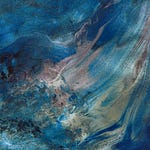Om carved in our bookcase shelves by Peter Smith
I remember very clearly, the first time I saw the symbol OM. I had borrowed a book from my parent’s bookshelf in the living room, perhaps I was about fifteen at the time. It was called “The Book of Stress Survival.” My parents both suffered from stress-related ailments. The book would have been a really great help to them. However, it was probably a bit too esoteric, yogic or just a bit too weird for them to engage in. In any case, I “borrowed” the book, taking it up to my bedroom to peruse over a long period of time, it became like a bible to me. Sadly, my parents didn’t notice its absence.
When I think back, reading this book was my first introduction to the world of yoga, to meditation and the asana practice and to the sacred symbol of OM. I remember turning the page to the section on Meditation Techniques and seeing the Sanskrit symbol for the first time. It was a beautifully drawn OM shaded in pencil. I remember tracing my finger over the curves, zoned out in a teenaged daydream, for a long time. I would draw the OM in my notebooks, on my school books, and on little bits of scrap paper over and over again. I couldn’t quite explain how the symbol touched me, but I immediately felt a familiarity, like it was a part of me.
The second major connection I had with OM was when I was nineteen. My friend and I were sitting with a Nepalese chai seller, in a very modest guest house room in Katmandu. Gradually more of the tea seller’s friends joined us in the tiny room, fragranced with the spicy, rich yak milk tea. The room was filled laughter, warmth and kindness, like a gathering of old friends. We talked for hours about life, the universe and everything.
I had just bought a bracelet on a market stall, with the symbols of OM MANE PADME HUM inscribed on it. The tea seller noticed it and thought for a little while, then said, “Yes, this is very special, very sacred, this symbol OM - you can repeat this… repeat it over and over. It will help you in your life.” I’ve been blessed to have been taught by many well-respected yoga teachers. Yet it is this kindly chai seller’s advice on the maha mantra, that I have followed most faithfully and hold most dear.
At those times in my life when my mind is full of worries and stress and I can’t sleep, I chant OM or OM MANE PADME HUM, silently, inside my mind and I feel myself drifting off. Even if I can’t sleep, I find it soothes my troubles and calms my nervous system, so that I feel rested. Chanting OM gives me inner strength, a sense of perspective and an inner knowing, that all is as it is meant to be, even when things are very tough.
I learned how to drive in my early thirties, and I was thrown in at the deep end. After I’d passed my test, every other weekend I’d make a long motorway journey to North Norfolk to help my Dad look after my mother who had early-onset Alzheimer’s Disease. I am not a natural-born driver. So driving on the motorways, and fast, unlit country roads, often in the lashing rain, was pretty scary. My co-driver was a blissfully sleeping toddler, my daughter Lucy…
In my Fiat Panda, I would silently (and sometimes not so silently) OM my way up the M11 and beyond. Once I arrived at my parent’s home, it enabled me to stay in my centre. Juggling the needs of Lucy, with the intense stress of my father and the bizarre, unpredictable behaviour of my mother was no mean feat. Chanting OM definitely helped to ground me, when there was no chance of actually doing any meditation or asana practice.
Sometimes, when I feel really happy and blessed, I will sing OM MANE PADME HUM in the way that my sound healing teacher Jill Purce taught me. And of course, I love the vibrations of the OM chanting at the end of a yoga class. Since the pandemic, I’ve been teaching mostly somatics, so I rarely get a chance to bathe in the beautiful sound of a circle of OMs. I am looking forward to the day when we’ll chant OM together again in the Spring. :-)
In 2018-19 I became really interested in the ideas of oppression, social and environmental justice and cultural appropriation. I was at an Extinction Rebellion protest and a Hare Krishna devotee noticed the silver OM pendant on my necklace, a present from a dear friend who travels to Nepal regularly, as she owns a hand-woven rug company. The orange-robed man challenged me by saying, “I see you are wearing an OM, do you know the real meaning of this symbol?”
I felt very self-conscious as I wasn’t sure if my answer would be the “right” the one that respected his culture and heritage, I was worried I would cause offence. I wanted to say “OM is the sacred sound of the Universe” I wished to discuss the dimensions of time and space that are encoded within the symbol. However, something in me froze, and instead, I just hurried along instead of stopping to talk and connect. After that, I took my OM pendant off. I felt that perhaps I didn’t have the right to wear this sacred symbol anymore, because it didn’t come from my own culture. And because people might assume I was merely using this symbol for decorative purposes.
So, here is my understanding of Om. Which comes from the Mandukya Upanishad, and all the explorations and discussions that I’ve been blessed to have over the years of studying yoga with a variety of teachers from various yoga traditions. Sadly, this wisdom was not on the tip of my tongue that rebellious day in Central London, but it is within me, and for that I am grateful.
The symbol has various parts to it, which each have a different meaning
Om is known as the maha mantra, the great mantra. In Sanskrit, OM is pronounced just as simply as it is written, there is no elongation of the O sound, and there is no ennunciation of the vowel sounds. This is the purest way of chanting OM. However, an elongated form of the mantra AUM, is also often heard and taught. The AUM (aahhh---oooo---mmmm) sound is said to reside within the OM, as described in the Mandukya Upanishad. So there are at least two (probably more) ways of pronouncing OM. There are many different symbols for Om, as it is a universal concept that exists in many languages. The OM symbol above is the Devanāgarī, Sanskrit symbol, and is the one we are most familiar with.
The AUM way of chanting expresses the meaning contained within the curves of the symbol as described in the Mandukya Upanishad. The shape that the mouth makes when chanting in this way, moves from a wide circle to a point, symbolising the movement from a more external, dissipated state to a more internally focussed “one pointed” state. This is the journey inwards towards the bindu, it is essentially the journey of yoga itself.
The bindu is a point that represents each particle in existence, it is akin to the spiritual nucleus of a cell. On a more macrocosmic level, in our human personality the bindu resides within the anandamayakosha (the bliss body) it is said to be located at the top of the back of the head. From this point we can connect our own infinite Individual Consciousness (Atman) with the underlying infinite Cosmic Consciousness (Brahman). In this way we realise our Oneness, with the entire Universe and our interconnectedness with all the other points of infinite consciousnesses at a cellular and organismal level.
We can get a bit lost in the philosophy of yoga in that it seems so ponderous, cosmological and abstract. However, the realisation of our interconnectedness can be very simple, heartfelt and kind. This is the understanding that infinite consciousness resides everywhere, in everything and every being around us. Life is alive with vibration, meaning and intelligence. A simple way to connect to this idea, to feel your own energetic centre, and to connect with others, is to simply chant OM. As the chai seller recommended… it will help you in your life.
Classes are on as usual. I’m still in hibernation mode, so it’s a small timetable of group classes, plus one to one lessons. You can book the free Meditation, a group in-person or Zoom Somatics class on the Holistic Yoga timetable, just click the button below.
With love and good wishes,
Julia













Share this post